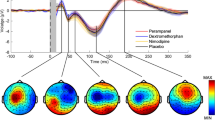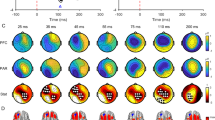Abstract
To investigate different cortical effects of lamotrigine and valproic acid, 30 paid healthy adult men were given, in a randomized/blinded fashion on three separate days (separated by a week), either a single dose of lamotrigine 325 mg, or a single dose of valproic acid 1,250 mg, or placebo. Resting motor threshold (RMT), cortical silent period (CSP) and motor evoked potential recruitment curves (RC) were assessed at baseline and 3 h after administration of each medication (or placebo). Lamotrigine caused a significant increase (63.32 vs. 69.25) in the RMT, compared with an insignificant increase following valproic acid (62.50 vs. 63.35), and a decrease (62.60 vs. 62.36) following placebo (F 2,26 = 18.58, P < 0.0001). No significant difference in CSP was found between placebo and drugs (F 2,26 = 0.119, P > 0.05). RCs were significantly suppressed by lamotrigine (t = 2.07, P < 0.05) and enhanced by valproic acid (t = 2.39, P < 0.05). Lamotrigine and valproic acid have different effects on cortical neuronal excitability as demonstrated by TMS.


Similar content being viewed by others
References
Annett M (1970) A classification of hand preference by association analysis. Br J Psychol 61:303–321
Borckardt JJ, Nahas Z, Koola J, George MS (2006) Estimating resting motor thresholds in transcranial magnetic stimulation research and practice: a computer simulation evaluation of best methods. J Ect 22:169–175
Boroojerdi B (2002) Pharmacologic influences on TMS effects. J Clin Neurophysiol 19:255–271
Boroojerdi B, Battaglia F, Muellbacher W, Cohen LG (2001) Mechanisms influencing stimulus-response properties of the human corticospinal system. Clin Neurophysiol 112:931–937
Brouwer B, Ashby P (1990) Corticospinal projections to upper and lower limb spinal motoneurons in man. Electroencephalogr Clin Neurophysiol 76:509–519
Brouwer B, Ashby P (1992) Corticospinal projections to lower limb motoneurons in man. Exp Brain Res 89:649–654
Bryk AS, Raudenbush SW (1987) Application of hierarchical linear models to assessing change. Psychol Bull 101:147–158
Bryk AS, Raudenbush SW (1992) Hierachical linear models: applications and data analysis methods. Sage Publications, Newbury Park
Cantello R, Civardi C, Varrasi C, Vicentini R, Cecchin M, Boccagni C, Monaco F (2006) Excitability of the human epileptic cortex after chronic valproate: a reappraisal. Brain Res 1099:160–166
Devanne H, Lavoie BA, Capaday C (1997) Input–output properties and gain changes in the human corticospinal pathway. Exp Brain Res 114:329–338
Di Lazzaro V, Oliviero A, Meglio M, Cioni B, Tamburrini G, Tonali P, Rothwell JC (2000) Direct demonstration of the effect of lorazepam on the excitability of the human motor cortex. Clin Neurophysiol 111:794–799
First MB, Spitzer RL, Gibbon M, Williams JBW (1995) Structured clinical interview for DSM-IV I disorder. American Psychiatric Association, Washington
Fuhr P, Agostino R, Hallett M (1991) Spinal motor neuron excitability during the silent period after cortical stimulation. Electroencephalogr Clin Neurophysiol 81:257–262
Garvey MA, Ziemann U, Becker DA, Barker CA, Bartko JJ (2001) New graphical method to measure silent periods evoked by transcranial magnetic stimulation. Clin Neurophysiol 112:1451–1460
Gobbi G, Janiri L (2006) Sodium- and magnesium-valproate in vivo modulate glutamatergic and GABAergic synapses in the medial prefrontal cortex. Psychopharmacology (Berl) 185:255–262
Hallett M (1995) Transcranial magnetic stimulation. Negative effects. Adv Neurol 67:107–113
Hattemer K, Knake S, Reis J, Oertel WH, Rosenow F, Hamer HM (2006) Cyclical excitability of the motor cortex in patients with catamenial epilepsy: a transcranial magnetic stimulation study. Seizure 15:653–657
Inghilleri M, Berardelli A, Cruccu G, Manfredi M (1993) Silent period evoked by transcranial stimulation of the human cortex and cervicomedullary junction. J Physiol 466:521–534
Inghilleri M, Berardelli A, Marchetti P, Manfredi M (1996) Effects of diazepam, baclofen and thiopental on the silent period evoked by transcranial magnetic stimulation in humans. Exp Brain Res 109:467–472
Johannessen CU (2000) Mechanisms of action of valproate: a commentatory. Neurochem Int 37:103–110
Kazis DA, Kimiskidis VK, Papagiannopoulos S, Sotirakoglou K, Divanoglou D, Vlaikidis N, Mills KR, Kazis A (2006) The effect of valproate on silent period and corticomotor excitability. Epileptic Disord 8:136–142
Lee HW, Seo HJ, Cohen LG, Bagic A, Theodore WH (2005) Cortical excitability during prolonged antiepileptic drug treatment and drug withdrawal. Clin Neurophysiol 116:1105–1112
Li X, Teneback CC, Nahas Z, Kozel FA, Large C, Cohn J, Bohning DE, George MS (2004) Interleaved transcranial magnetic stimulation/functional MRI confirms that lamotrigine inhibits cortical excitability in healthy young men. Neuropsychopharmacology 29:1395–1407
Loscher WN, Nordlund MM (2002) Central fatigue and motor cortical excitability during repeated shortening and lengthening actions. Muscle Nerve 25:864–872
Manganotti P, Bongiovanni LG, Zanette G, Turazzini M, Fiaschi A (1999) Cortical excitability in patients after loading doses of lamotrigine: a study with magnetic brain stimulation. Epilepsia 40:316–321
Mills KR, Kimiskidis V (1996) Motor cortex excitability during ballistic forearm and finger movements. Muscle Nerve 19:468–473
Priori A, Berardelli A, Inghilleri M, Accornero N, Manfredi M (1994) Motor cortical inhibition and the dopaminergic system. Pharmacological changes in the silent period after transcranial brain stimulation in normal subjects, patients with Parkinson’s disease and drug-induced parkinsonism. Brain 117(Pt 2):317–323
Reis J, John D, Heimeroth A, Mueller HH, Oertel WH, Arndt T, Rosenow F (2006) Modulation of human motor cortex excitability by single doses of amantadine. Neuropsychopharmacology 31:2758–2766
Reutens DC, Puce A, Berkovic SF (1993) Cortical hyperexcitability in progressive myoclonus epilepsy: a study with transcranial magnetic stimulation. Neurology 43:186–192
Roberts DR, Ricci R, Funke FW, Ramsey P, Kelley W, Carroll JS, Ramsey D, Borckardt JJ, Johnson K, George MS (2007) Lower limb immobilization is associated with increased corticospinal excitability. Exp Brain Res 181:213–220
Rothwell JC (1997) Techniques and mechanisms of action of transcranial stimulation of the human motor cortex. J Neurosci Methods 74:113–122
Schulze-Bonhage A, Knott H, Ferbert A (1996) Effects of carbamazepine on cortical excitatory and inhibitory phenomena: a study with paired transcranial magnetic stimulation. Electroencephalogr Clin Neurophysiol 99:267–273
Smith MJ, Adams LF, Schmidt PJ, Rubinow DR, Wassermann EM (2002) Effects of ovarian hormones on human cortical excitability. Ann Neurol 51:599–603
Stefan H, Feuerstein TJ (2007) Novel anticonvulsant drugs. Pharmacol Ther 113:165–183
Tassinari CA, Cincotta M, Zaccara G, Michelucci R (2003) Transcranial magnetic stimulation and epilepsy. Clin Neurophysiol 114:777–798
Tergau F, Wischer S, Somal HS, Nitsche MA, Mercer AJ, Paulus W, Steinhoff BJ (2003) Relationship between lamotrigine oral dose, serum level and its inhibitory effect on CNS: insights from transcranial magnetic stimulation. Epilepsy Res 56:67–77
Werhahn KJ, Kunesch E, Noachtar S, Benecke R, Classen J (1999) Differential effects on motorcortical inhibition induced by blockade of GABA uptake in humans. J Physiol 517(Pt 2):591–597
Ziemann U (2004) TMS and drugs. Clin Neurophysiol 115:1717–1729
Ziemann U, Lonnecker S, Paulus W (1995) Inhibition of human motor cortex by ethanol. A transcranial magnetic stimulation study. Brain 118(Pt 6):1437–1446
Ziemann U, Bruns D, Paulus W (1996a) Enhancement of human motor cortex inhibition by the dopamine receptor agonist pergolide: evidence from transcranial magnetic stimulation. Neurosci Lett 208:187–190
Ziemann U, Lonnecker S, Steinhoff BJ, Paulus W (1996b) The effect of lorazepam on the motor cortical excitability in man. Exp Brain Res 109:127–135
Ziemann U, Lonnecker S, Steinhoff BJ, Paulus W (1996c) Effects of antiepileptic drugs on motor cortex excitability in humans: a transcranial magnetic stimulation study. Ann Neurol 40:367–378
Ziemann U, Lonnecker S, Steinhoff BJ, Paulus W (1999) Motor excitability changes under antiepileptic drugs. Adv Neurol 81:291–298
Acknowledgments
The authors would like to thank Dr Jeffrey Borckardt for running HLM analysis. This study was funded primarily by an unrestricted research grant from GlaxoSmithKline to Dr George, as well as from Center for Advanced Imaging Research and Brain Stimulation Laboratory infrastructure and resources. CHL is a full-time employee of GlaxoSmithKline S.p.A. None of the other authors have equity or financial conflicts. Drs Li and George had full access to all of the data in the study and take responsibility for the integrity of the data and the accuracy of the data analysis. Presented in abstract form at the annual meeting of American College of Neuropsychopharmacology, Hollywood, FL, USA, December 14, 2006 and the annual meeting of the Society of Biological Psychiatry, San Diego, CA, USA, May 21, 2007.
Author information
Authors and Affiliations
Corresponding author
Rights and permissions
About this article
Cite this article
Li, X., Ricci, R., Large, C.H. et al. Lamotrigine and valproic acid have different effects on motorcortical neuronal excitability. J Neural Transm 116, 423–429 (2009). https://doi.org/10.1007/s00702-009-0195-z
Received:
Accepted:
Published:
Issue Date:
DOI: https://doi.org/10.1007/s00702-009-0195-z




